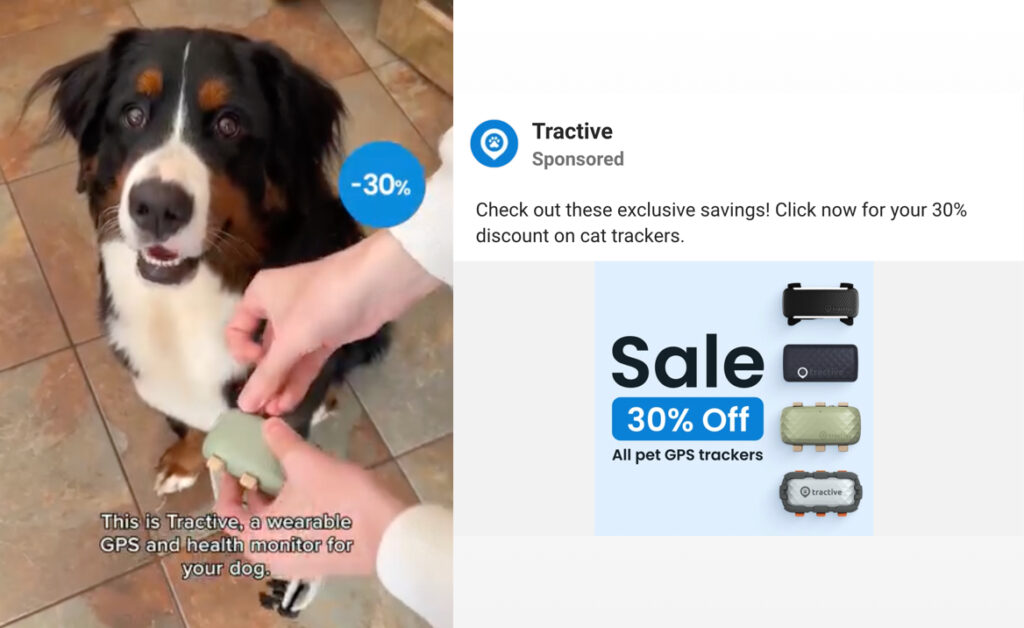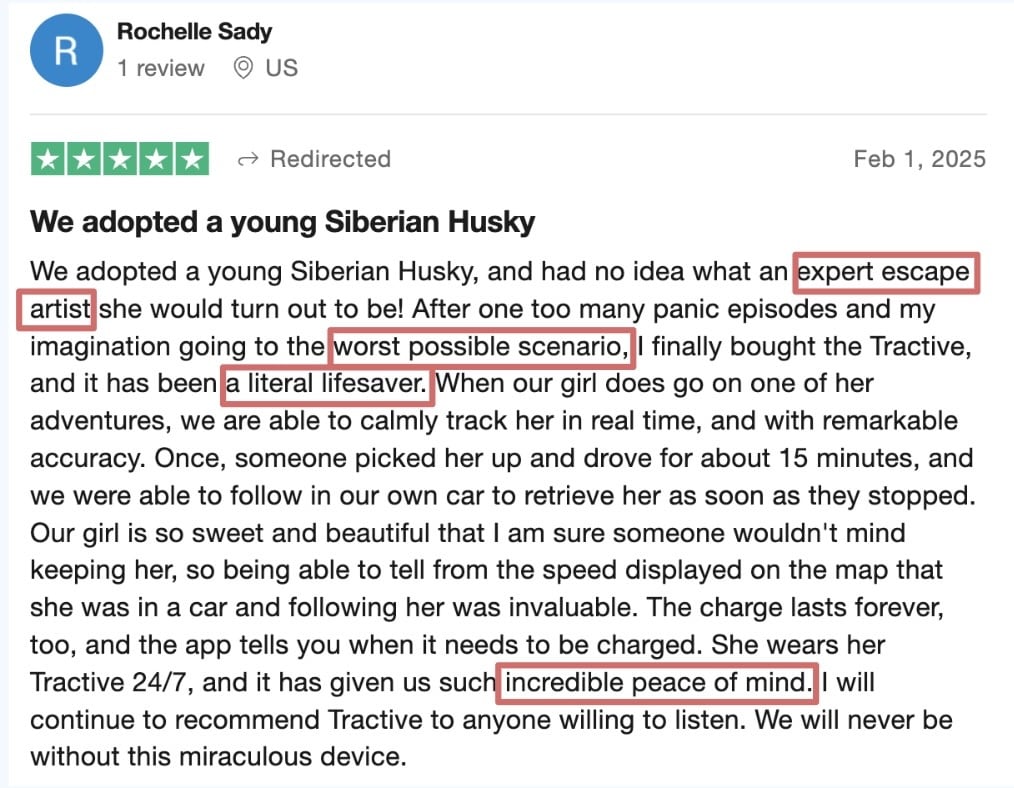The Real Reason I Bought That Dog Tracker: A JTBD Framework for Your Ecommerce Funnel
I lost my dog. Not in a park or even near my home, although that’s happened plenty of times before. No, this time, I lost my dog in a giant forest that spans miles and miles, thirty minutes before it was due to get dark.
Of course, the AirTag didn’t work, as no one was close enough—fun fact: AirTags rely solely on nearby Apple products to coordinate a location, which isn’t much help in a forest. Of course, he didn’t respond to the frantic calls for him—“LOKI!”
Thankfully, we found him in the end. It turns out he’d got stuck in an area surrounded by nettles about ten metres from where we’d originally lost him. Rather than bark to alert us of his predicament, he sat there in silence and waited.
Losing my dog resulted in a £281.30 shopping spree.
I gave in and bought a Tractive GPS tracker and the lovely two-year plan that came with it.


I think it took me less than a minute to go through the whole journey. I’m the ideal customer, right?

Wrong. I’ve had my dog for five years, and this is not the first great escape my half-husky has made. Just a few months before, my sister lost him while taking care of him. It all started so well.
Again, don’t worry. At that time, he was relaxing at the lovely heritage house, Kenwood House. Given that this is a dog-free zone, staff quickly found him, called us, and he was reluctantly returned to my sister’s care.
It wasn’t that I wasn’t aware of solutions and options out there, but rather that I’d never been convinced by Tractive. My fellow dog owning friends had told me about them, and I’d seen their ads:

But all they talked about was tracking and health monitoring, and they didn’t mention my Job to Be Done:
When I lose my dog
I want to find him as soon as possible
So I can know he’s okay (and probably tell him off)
So many companies make this mistake, just like I make the mistake of ever letting him off-leash. Companies focus on what our product is and the category it falls into. Yet, at the end of the day, it is what your customer is trying to achieve—aka their Jobs to be Done (JTBD).JTBD is understanding your customer’s goal and the thought process that leads them to your product. It is the why behind it all.

So, how do you understand your JTBD? I follow a four-step process:
1. Review Mining
With review mining, the goal is to extract golden nuggets about your customers—what do they focus on? We then use this information for copywriting, using our customers’ own language to relate to them.
This is Tractive’s current benefits block, and it’s the same language they use across their website, mentioning GPS tracking, health tracking, and activity monitoring:

Yet their reviews tell a different story, filled with the emotions and struggles of their audience:

I like to gather these in a structured way using a spreadsheet. I note down the pains, gains, and JTBD in each review:

You could definitely use AI for this, too, but I do find it still generalizes a bit too much. Nothing beats reading endless customer reviews. Trust me, it’s a great investment of your time.
2. Conducting a Competitor Analysis
Looking at competitors will help you:
- Understand how they are positioning themselves
- Notice what copy they use
- Inspire different ways to communicate with your target audience
- Uncover how you can stand out from the crowd
Now, for Tractive, their competitors aren’t just other GPS trackers or AirTags; they’re also obedience classes that keep your dog on the leash.
Basically, you need to think outside of the box when it comes to recognizing competitors.
I usually create one big Google Sheet or Airtable with all the competitors, directly and indirectly, and make notes of their positioning. I’ve found that reading their reviews is also a great way to understand what people love and dislike about them, so you can apply these learnings to your own brand.
3. Surveying Your Customers
If you have a large database, start with surveying:
- Most frequent — They buy your product regularly. (What “regular” looks like depends on your product.)
- Highest Average Order Value / Spend — They are in the top 10% – 15% in terms of spend and their AOV tends to skew higher.
- Purchased recently — Have bought within the last period. (Again, duration depends on how often you expect them to buy.)
This will help you identify multiple potential JTBD, which you can prioritize and explore further in interviews. Otherwise, you might end up with far too many JTBD mentioned, and interviews might be needed to narrow it down.
The main question you should ask them is: what led you to try out [our brand]?
If you have a really large audience, you can analyze each segment of responses and look at how much they spend, how often they buy, etc., to identify the most valuable JTBD for you.
4. Conducting User Interviews
The goal of user interviews is to:
- Dive deep into the JTBD of your ‘raving fan’ customers
- Understand what they believe differentiates your brand from competitors
- Compare the JTBD of ‘raving fans’ with those of churned customers (by interviewing both)
Here are some questions I like to ask:
- What other solutions did you try before deciding on [XYZ]?
- What did you like and dislike about the other solutions you had tried?
- What led you to try out [XYZ]?
- How did you go about finding a new solution?
- Did you have any questions or concerns before trying out [XYZ]?
- If you could no longer use [XYZ], what would you use instead?
- Have you set a budget for [XYZ] or another solution?
For question three, the goal is to really want to dive into that moment—the moment they decided to switch to your brand.
Bringing this all together should enable you to understand what your customers are trying to achieve and help you create a JTBD statement around it:

Really focus on JTBD where you can help the customer in ways competitors aren’t. For example, for Tractive:
- AirTag: Can’t track over long distances and relies on phones being nearby
- Long leash/keeping on leash: Doesn’t address the high energy levels your dog still has
- Obedience classes: Rarely completely override a hunting dog’s natural instincts
How to Use This for Your Full Funnel
For your ads:
- Show the desired outcomes your customers want to achieve, not just your discounts or product features
- Talk about the pains and challenges they face
- Focus on their JTBD
For your landing page:
- Use actual customer language, rather than your own
- Show relatable customers in relatable situations
- Consider the emotions the customer is feeling in that moment
- Use FAQs to address real challenges
Beyond that:
- Think beyond ads and the website in terms of how to speak to their JTBD (e.g., email, social media, etc.)
- Adjust your product offering to what will help them further achieve their JTBD (e.g., what combinations make sense)
- Use email to build further understanding and trust by creating specific, personalized flows speaking to their JTBD
Losing my dog may have cost me £281.30, but Tractive missed out on £600 of potential revenue, if only they’d focused on my JTBD sooner.
Written By
Daphne Tideman
Edited By
Carmen Apostu


